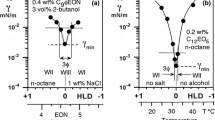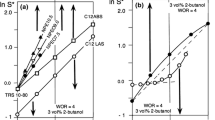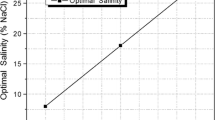Abstract
Upon dilution by the petroleum reservoir connate water, the anionic commercial surfactant blend often used in enhanced oil recovery by low tension, becomes more lipophilic at the interface because of so-called selective partitioning. Hence, the optimum formulation is not maintained when the injected slug moves through the reservoir. An opposite variation is found for ethoxylated nonionic surfactant systems. As a consequence of these antagonistic influences, the optimum formulation shift produced by dilution may be eliminated by using an appropriate mixture of anionic and nonionic commercial surfactants, so that the two effects exactly cancel out.




Similar content being viewed by others
Abbreviations
- SAD:
- HLD:
-
Hydrophilic-lipophilic deviation defined in Eqs. (1) and (2)
- ACN:
-
Alkane carbon number
- PSMW425:
-
Petroleum sulfonate sodium salt with an average molecular weight of 425
- PSHL:
-
Petroleum sulfonate sodium salt with a molecular weight range of 440 to 470
- C12OXS:
-
Dodecyl orthoxylene sulfonate sodium salt
- NP6EO:
-
Commercial ethoxylated nonylphenol with an average of 6 ethylene oxide groups
- EON:
-
Average number of ethylene oxide groups per molecule
- S :
-
Salinity of aqueous phase (in wt% NaCl)
- σ :
-
Characteristic parameter of an anionic surfactant
- β :
-
Characteristic parameter of a nonionic surfactant
- f(A) and ϕ(A):
-
Functions representing the effect of the type and concentration of alcohol
- T :
-
Temperature (° C)
- k, b, aT, cT:
References
Shah DO, Schechter RS (eds) (1977) Improved oil recovery by surfactant and polymer flooding. Academic Press, New York, USA
Cayias JL, Schechter RS, Wade WH (1977) Utilization of petroleum sulfonates for producing low tension between hydrocarbons and water. J Colloid Interface Sci 59:31–38
Lake L (1989) Enhanced oil recovery. Prentice Hall, Englwood Cliffs, NJ
Bourrel M, Schechter RS (1988) Microemulsions and related systems. Marcel Dekker, New York
Winsor P (1954) Solvent properties of amphiphilic compounds. Butterworths, London, UK
Salager JL, Vasquez E, Morgan J, Schechter RS, Wade WH (1979) Optimum formulation of surfactant-water-oil systems for minimum interfacial tension and phase behavior. Soc Petrol Eng J 19:107–115
Bourrel M, Salager JL, Schechter RS, Wade WH (1980) A correlation for phase behavior of nonionic surfactants. J Colloid Interface Sci 75:451–461
Wade WH, Morgan JC, Schechter RS, Jacobson JK, Salager JL (1978) Interfacial tension and phase behavior of surfactant systems. Soc Petrol Eng 18:242–252
Salager JL (1988) Phase transformation and emulsion inversion on the basis of catastrophe theory. In: Becher P (ed) Encyclopedia of emulsion technology, vol 3. Marcel Dekker, New York, USA, pp 79–134
Salager JL (1999) Microemulsions. In: Broze G (ed) Handbook of detergents—part A: properties. Marcel Dekker, New York, pp 253–302
Salager JL, Márquez N, Graciaa A, Lachaise J (2000) Partitioning of ethoxylated octylphenol surfactants in microemulsion-oil-water systems. Influence of temperature and relation between partitioning coefficient and physicochemical formulation. Langmuir 16:5534–5539
Salager JL, Antón RE, Andérez JM, Aubry JM (2001) Formulation des micro-émulsions par la méthode HLD. In: Techniques de l’Ingénieur. Chap 157 Vol. Génie des ProcédésJ2, pp 1–20
Healy RL, Reed RN (1977) Some physicochemical aspects of microemulsion flooding: a review. In: Shah DO, Schechter RS (eds) Improved oil recovery by surfactant and polymer flooding. Academic Press, New York, pp 347–383
Kunieda H, Solans C (1997) How to prepare microemulsions: temperature insensitive microemulsions. In: Solans C, Kunieda H (eds) Industrial applications of microemulsions. Marcel Dekker, New York, pp 21–45
Queste S, Salager JL, Strey R, Aubry JM (2007) The EACN scale for oil classification revisited thanks to fish diagrams. J Colloid Interface Sci 312:98–107
Kunz W, Testard F, Zemb T (2009) Correspondence between curvature, packing parameter and hydrophilic-lipophilic deviation scales around the phase inversion temperature. Langmuir 25:112–115
Haegel FH, Lopez JC, Salager JL, Engelskirchen S (2009) Microemulsions in large scale applications. In: Stubenrauch C (ed) Microemulsions—background new concepts applications, perspectives. Blackwell Pub, Oxford UK, pp 302–344
Crook EH, Fordyce DB, Trebbi GF (1963) Molecular weight distribution of nonionic surfactants I. Surface and interfacial tension or normal distribution and homogeneous p,t-octylphenoxyethanols (OPE’S). J Phys Chem 67:1987–1994
Márquez N, Antón RE, Graciaa A, Lachaise J, Salager JL (1995) Partitioning of ethoxylated alkylphenol surfactants in microemulsion-oil-water systems. Colloids Surf A 100:225–231
Zornes DR, Willhite GP, Michnick MJ (1978) An experimental investigation into the use of high pressure liquid chromatography for the determination of petroleum sulfonates. Soc Petrol Eng J 18:207–218
Koukounis C (1979) Phase partitioning and fractionation of anionic and nonionic surfactant mixtures. MSc Thesis, University of Texas at Austin
Graciaa A, Lachaise J, Bourrel M, Osborne-Lee I, Schecheter RS, Wade WH (1987) The partitioning of nonionic and anionic surfactant mixtures between oil/microemulsion/water phases. SPE Reservoir Eng 2:305–314
Bourrel M, Koukounis C, Schechter RS, Wade WH (1980) Phase and interfacial tension behavior of nonionic surfactants. J Dispers Sci Technol 1:13–35
Graciaa A, Lachaise J, Sayous JG, Grenier P, Yiv S, Schechter RS, Wade WH (1983) The partitioning of complex surfactant mixtures between oil-water-microemulsion phases at high surfactant concentration. J Colloid Interface Sci 93:474–486
Graciaa A, Andérez JM, Bracho C, Lachaise J, Salager JL, Tolosa L, Ysambertt F (2006) The selective partitioning of the oligomers of polyethoxylated surfactant mixtures between interface and oil and water bulk phases, Adv Colloid Interface Sci 123–126:63–73
Kahlweit M, Lessner E, Strey R (1983) Influence of the properties of the oil and the surfactant on the phase behavior of systems of the type H2O-oil-nonionic surfactant. J Phys Chem 87:5032–5040
Kilpatrick PK, Gorman CA, Davis HT, Scriven LE, Miller WG (1986) Patterns of phase behavior in ternary ethoxylated alcohol-n-alkane-water mixture. J Phys Chem 90:5292–5299
Antón RE, Andérez JM, Bracho CL, Véjar F, Salager JL (2008) Practical surfactant mixing rules based on the attainment of microemulsion-oil-water three-phase behavior systems. Adv Polymer Sci 218:83–113
Salager JL (1977) Physicochemical properties of surfactant-oil-water mixtures: phase behavior, microemulsion formation and interfacial tension. PhD Dissertation, University of Texas at Austin
Sayous JG (1983) Etude du partage de tensioactifs nonioniques entre phases de systèmes de Winsor. PhD Dissertation (In French). Université de Pau PA, Pau, France
Rosen MJ (2004) Micelle Formation by Surfactants. In Surfactants and interfacial phenomena. Wiley-Interscience. John Wiley, Hoboken, pp 134
Acosta EJ, Harwell JH, Sabatini DA (2004) Self-assembly in linker-modified microemulsions. J Colloid Interface Sci 274:652–664
Schick M (ed) (1967) Nonionic surfactants. Marcel Dekker, New York
Goel SK (1998) Tuning the polydispersity of alcohol ethoxylates for enhanced oily soil removal. J Surfactants Deterg 1:539–545
Márquez N, Antón RE, Graciaa A, Lachaise J, Salager JL (1995) Partitioning of ethoxylated alkyl phenol surfactants in microemulsion-oil-water systems. Colloids Surf A 100:225–231
Salager JL, Bourrel M, Schechter RS, Wade WH (1979) Mixing rules for optimum phase behavior formulations of surfactant-oil-water systems. Soc Petrol Eng J 19:271–278
Salager JL, Antón RE, Forgiarini A, Márquez L (2009) Formulation of Microemulsions. In: Stubenrauch C (ed) Microemulsions—background new concepts applications, perspectives. Blackwell Pub, Oxford UK, pp 84–121
Antón RE, Salager JL, Graciaa A, Lachaise J (1992) Surfactant-oil-water systems near the affinity inversion—part VIII: optimum formulation and phase behavior of mixed anionic-nonionic systems versus temperature. J Dispers Sci Technol 13:565–579
Hirasaki G, Van Domselar HR, Nelson RC (1980) Evaluation of the salinity gradient concept in surfactant flooding. Paper SPE 8825, 1rst joint SPE/DOE symposium in enhanced oil recovery, Tulsa OK, 20–23 Apr 1980
Acknowledgments
The authors are grateful to their university research council CDCHT, for a partial financial backing. One of the authors (MAA) would like to thank FONACIT, an agency of the Venezuelan Ministry of Science and Technology for granting her a doctoral scholarship.
Author information
Authors and Affiliations
Corresponding author
About this article
Cite this article
Arandia, M.A., Forgiarini, A.M. & Salager, JL. Resolving an Enhanced Oil Recovery Challenge: Optimum Formulation of a Surfactant-Oil–Water System Made Insensitive to Dilution. J Surfact Deterg 13, 119–126 (2010). https://doi.org/10.1007/s11743-009-1171-1
Received:
Accepted:
Published:
Issue Date:
DOI: https://doi.org/10.1007/s11743-009-1171-1




